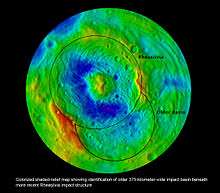Veneneia
Veneneia /vɛnɪˈniːə/ is the second-largest crater on asteroid 4 Vesta, at 52°S latitude. 395 kilometres (245 mi)[1] in diameter, it is 70% of the equatorial diameter of the asteroid, and one of the largest craters in the Solar System. It is at least 2 billion years old. However, it is overlain and partially obliterated by the even larger Rheasilvia. It was discovered by the Dawn spacecraft in 2011. It is named after Venēneia, one of the founding vestal virgins.[2]


Outline of Rheasilvia (top center), with Veneneia (bottom center) underlying it
Vesta has a series of troughs in the northern hemisphere concentric to Veneneia. These are believed to be large-scale fractures resulting from the impact. The largest is Saturnalia Fossa, approx. 39 km wide and > 400 km long.[3]
References
- 'Vesta seems more planet than asteroid', Science News, 2012 Mar 22
- Veneneia, Gazetteer of Planetary Nomenclature, 2012 Feb 28 (NASA coordinates)
- "EXPLORATION OF SATURNALIA FOSSA AND ASSOCIATED STRUCTURES IN VESTA'S NORTHERN HEMISPHERE". Archived from the original on 2014-02-03. Retrieved 2012-09-15.
This article is issued from Wikipedia. The text is licensed under Creative Commons - Attribution - Sharealike. Additional terms may apply for the media files.